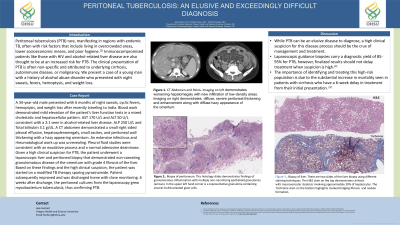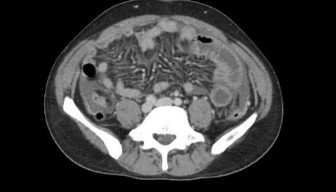Sunday Poster Session
Category: Liver
P1331 - Peritoneal Tuberculosis: An Elusive and Exceedingly Difficult Diagnosis
Sunday, October 27, 2024
3:30 PM - 7:00 PM ET
Location: Exhibit Hall E

Has Audio
- JH
Jake Herbert, DO, MS
Oregon Health & Science University
Portland, OR
Presenting Author(s)
Jake Herbert, DO, MS, Rafael Ornelas, MD, Scott Naugler, MD
Oregon Health & Science University, Portland, OR
Introduction: Peritoneal tuberculosis (PTB) rare, manifesting in regions with endemic TB, often with risk factors that include living in overcrowded areas, lower socioeconomic means, and poor hygiene. Immunocompromised patients like those with HIV and alcohol-related liver disease are also thought to be at an increased risk for PTB. The clinical presentation of PTB is often non-specific and attributed to underlying cirrhosis, autoimmune disease, or malignancy. We present a case of a young man with a history of alcohol abuse disorder who presented with night sweats, fevers, hemoptysis, and weight loss.
Case Description/Methods: A 34-year-old male presented with 6 months of night sweats, cyclic fevers, hemoptysis, and weight loss after recently traveling to India. Blood work demonstrated mild elevation of the patient’s liver function tests in a mixed cholestatic and hepatocellular pattern. AST 170 U/L and ALT 50 U/L consistent with a 2:1 seen in alcohol-related liver disease. ALP 250 U/L and Total bilirubin 3.1 g/dL. A CT abdomen demonstrated a small right sided pleural effusion, hepatosplenomegaly, small ascites, and peritoneal wall thickening with a hazy appearing omentum. An extensive infectious and rheumatological work up was unrevealing. Pleural fluid studies were consistent with an exudative process and a normal adenosine deaminase. Given a high clinical suspicion for PTB, the patient underwent a laparoscopic liver and peritoneal biopsy that demonstrated non-caseating granulomatous disease of the omentum with grade 4 fibrosis of the liver. Based on these findings and the high clinical suspicion, the patient was started on a modified TB therapy sparing pyrazinamide. Patient subsequently improved and was discharged home with close monitoring. 6 weeks after discharge, the peritoneal cultures from the laparoscopy grew mycobacterium tuberculosis, thus confirming PTB.
Discussion: While PTB can be an elusive disease to diagnose, a high clinical suspicion for this disease process should be the crux of management and treatment. Laparoscopic guidance biopsies carry a diagnostic yield of 85-95% for PTB, however, finalized results should not delay treatment when suspicion is high. The importance of identifying and treating this high-risk population is due to the substantial increase in mortality seen in patients with cirrhosis who have a 6-week delay in treatment from their initial presentation.

Disclosures:
Jake Herbert, DO, MS, Rafael Ornelas, MD, Scott Naugler, MD. P1331 - Peritoneal Tuberculosis: An Elusive and Exceedingly Difficult Diagnosis, ACG 2024 Annual Scientific Meeting Abstracts. Philadelphia, PA: American College of Gastroenterology.
Oregon Health & Science University, Portland, OR
Introduction: Peritoneal tuberculosis (PTB) rare, manifesting in regions with endemic TB, often with risk factors that include living in overcrowded areas, lower socioeconomic means, and poor hygiene. Immunocompromised patients like those with HIV and alcohol-related liver disease are also thought to be at an increased risk for PTB. The clinical presentation of PTB is often non-specific and attributed to underlying cirrhosis, autoimmune disease, or malignancy. We present a case of a young man with a history of alcohol abuse disorder who presented with night sweats, fevers, hemoptysis, and weight loss.
Case Description/Methods: A 34-year-old male presented with 6 months of night sweats, cyclic fevers, hemoptysis, and weight loss after recently traveling to India. Blood work demonstrated mild elevation of the patient’s liver function tests in a mixed cholestatic and hepatocellular pattern. AST 170 U/L and ALT 50 U/L consistent with a 2:1 seen in alcohol-related liver disease. ALP 250 U/L and Total bilirubin 3.1 g/dL. A CT abdomen demonstrated a small right sided pleural effusion, hepatosplenomegaly, small ascites, and peritoneal wall thickening with a hazy appearing omentum. An extensive infectious and rheumatological work up was unrevealing. Pleural fluid studies were consistent with an exudative process and a normal adenosine deaminase. Given a high clinical suspicion for PTB, the patient underwent a laparoscopic liver and peritoneal biopsy that demonstrated non-caseating granulomatous disease of the omentum with grade 4 fibrosis of the liver. Based on these findings and the high clinical suspicion, the patient was started on a modified TB therapy sparing pyrazinamide. Patient subsequently improved and was discharged home with close monitoring. 6 weeks after discharge, the peritoneal cultures from the laparoscopy grew mycobacterium tuberculosis, thus confirming PTB.
Discussion: While PTB can be an elusive disease to diagnose, a high clinical suspicion for this disease process should be the crux of management and treatment. Laparoscopic guidance biopsies carry a diagnostic yield of 85-95% for PTB, however, finalized results should not delay treatment when suspicion is high. The importance of identifying and treating this high-risk population is due to the substantial increase in mortality seen in patients with cirrhosis who have a 6-week delay in treatment from their initial presentation.

Figure: CT Imaging Demonstrating Hazy Omentum
Disclosures:
Jake Herbert indicated no relevant financial relationships.
Rafael Ornelas indicated no relevant financial relationships.
Scott Naugler indicated no relevant financial relationships.
Jake Herbert, DO, MS, Rafael Ornelas, MD, Scott Naugler, MD. P1331 - Peritoneal Tuberculosis: An Elusive and Exceedingly Difficult Diagnosis, ACG 2024 Annual Scientific Meeting Abstracts. Philadelphia, PA: American College of Gastroenterology.
